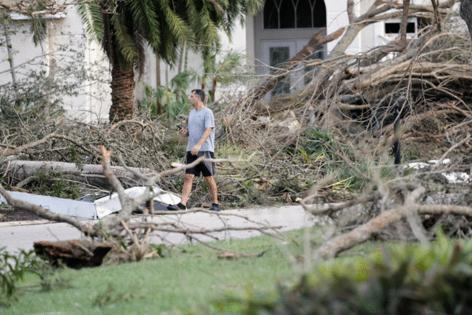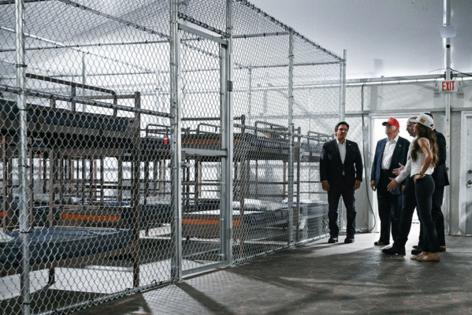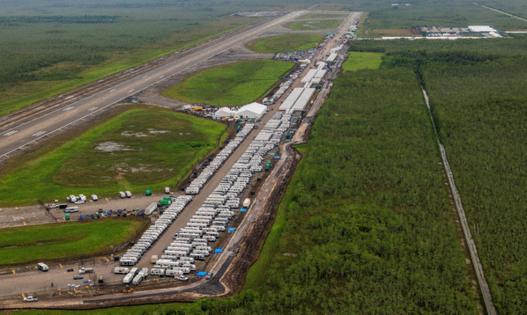Alligator Alcatraz and hurricanes: Here's what would put the site at particular risk
Published in News & Features
ORLANDO, Fla. — As Florida enters peak hurricane season, questions persist about the safety of the detainees as well as staff housed at Alligator Alcatraz, the tent city quickly erected to hold migrants in the middle of the Everglades.
Specifically, rapid storm intensification, flooding and a storm approaching from the Gulf could create deadly scenarios for anyone living in a tent in the Everglades.
The state released a heavily redacted 33-page document on Wednesday detailing the plan for a full-scale evacuation of the facility, but most of the information was blacked out.
A section called “Activation Procedures,” which may detail how and when the state would make the decision to evacuate the facility, was entirely redacted.
Kevin Guthrie, director of Florida’s Division of Emergency Management, stated emphatically at a recent news conference that the temporary structures that house detainees can withstand a Category 2 storm with sustained winds of 96 mph to 110 mph. “I promise you that the hurricane guys have got the hurricane stuff covered,” Guthrie said.
Hurricane categories only rate wind speed and don’t address risks such as rapid intensification, storm surge, tornadoes and the travel speed of the storm.
Alligator Alcatraz, which sits inside Big Cypress National Preserve, is susceptible to a hurricane strike from nearly any direction.
With rapid intensification of storms increasing in recent decades, a tropical storm can ramp up into a Category 3 hurricane in a day.
Therefore, any evacuation decision would need to include factors beyond a hurricane’s category.
The South Florida Sun Sentinel contacted Florida’s Division of Emergency Management for more information about how long an evacuation would take, the number of buses needed to evacuate detainees and the source of those buses. It also asked how the state was factoring rapid intensification, flooding and storm surge into its evacuation plan.
The emergency management division has not yet responded.
Here’s a look at some of the forces that put Alligator Alcatraz at particular risk.
Rapid intensification
Hurricanes have been intensifying more rapidly in recent decades, making it more difficult for emergency officials to assess risk and organize evacuations. The National Hurricane Center classifies any storm that gains 35 mph or more of maximum sustained wind speed in a 24-hour period as “rapidly intensifying.”
In 2024, Hurricane Helene jumped from Category 1 to Category 4, with 140 mph sustained winds within 24 hours of making landfall.
And in 2023, Hurricane Lee vaulted from a Category 1 to a Category 5 in a day, fortunately well out to sea. The same year, Hurricane Idalia leapt from a tropical storm to a Category 4 hurricane in just over 24 hours.
A 2023 study showed that hurricanes are intensifying more rapidly now than in the past. Globally, the amount of rapidly intensifying hurricanes in coastal zones (within about 250 miles from shore) tripled from 1980 to 2020.
The study attributed the trend to a rise in sea-surface temperatures due to climate change. Those higher water temperatures fuel hurricanes. Sea-surface temperatures need to be around 80 degrees or higher to spark rapid intensification.
What does that mean for Alligator Alcatraz? A safe-looking tropical storm traveling at a relatively fast 25 mph could cover 600 miles and jump to a deadly Category 4 storm in a day.
Which raises the question, how many days out does the state need to call for an evacuation, even if an approaching system is merely a tropical storm?
Fortunately, hurricane experts can predict the likelihood of rapid intensification based on the environment it’s traveling into. “The main factors are sea-surface temperature, wind shear, how a storm can vertically stack itself and organize, and also the moisture profile in the atmosphere,” said National Weather Service meteorologist George Rizzuto.
Dry air and wind shear would cripple the storm, but calm moist air and hot water would fuel it.
The width of a storm also is a factor. Wide sprawling storms take longer to intensify; compact storms can spin up more quickly, almost like a spinning figure skater rotating faster as they pull their arms in.
A storm’s posture — upright or tilted — also affects rapid intensification. An upright storm is more likely to intensify.
According to the National Oceanic and Atmospheric Administration, sea-surface temperatures for the end of July in the Atlantic are warmer than normal compared to the average since 1985, but not as anomalously hot as those in 2023 and 2024 for this time of year.
Storm speed
Alligator Alcatraz is 25 to 50 miles inland, depending on where a storm is coming from, but that doesn’t make it safe.
2024’s Hurricane Helene maintained hurricane strength 200 miles from landfall, into central Georgia.
And according to NOAA, hurricane-force wind gusts penetrated as far as 350 miles inland, to the mountains of western North Carolina.
1992’s Hurricane Andrew cut across the Everglades about 20 miles south of Alligator Alcatraz, but wind speeds in the area still reached Category 5, or 160 mph.
The storm cut nearby Miccosukee tribal members off from the rest of the world for two days.
“One of our major problems were the highways,” Tribal Police Chief Tony Zecca told the Sun Sentinel in 1992. “Everything was blocked by fallen trees. I was very concerned that we would have a medical emergency and no way to summon help.”
“They had no telephones, no electricity, no radios,” wrote the Sun Sentinel at the time. “Even the tribal police could not reach outside agencies.”
Flooding
In previous news conferences warning people to evacuate before hurricanes arrived, Gov. Ron DeSantis and Guthrie have emphasized that water kills more people than wind during and after storms. Alligator Alcatraz could be flooded by both rain and storm surge.
Additionally, storms can roll in from almost any direction.
1992’s Hurricane Andrew barreled in from the east coast and pummeled the area; in 2005, Hurricane Wilma shot in from the Gulf, causing wind gusts of 93 mph near Alligator Alcatraz; and in 2006, Ernesto came in from the south on a track that took it almost directly over the site.
Curtis Osceola, senior executive policy adviser for the Miccosukee Tribe who has expressed opposition to the detention site, grew up near the Alligator Alcatraz facility.
“Big Cypress is a rain-driven system, so when it rains heavily, the water stacks up and then moves south,” Osceola said. The southern flow of the Everglades would direct floodwaters toward Alligator Alcatraz, where the Tamiami Trail acts as a dam, stacking water up.
Osceola recalls that 2017’s Hurricane Irma shot in from the south and dropped as much as 20 inches of rain in Big Cypress. “That water just kind of washes over the runway (where the detainee tents sit),” Osceola said.
The raised runways of Alligator Alcatraz are 12.7 feet above sea level according to the FAA, slightly higher than the surrounding swamp, which ranges from 7 to 9 feet about sea level, according to the U.S. Geological Survey.
The other water threat is storm surge, which occurs when hurricane wind push water up into coastal areas.
During Helene, storm surge killed more than three times as many people as wind in Florida. The shallower the coastal water, the more a hurricane can pile it up. That’s why the Gulf coast is more susceptible than the deeper Atlantic coast.
The National Weather Service’s Rizzuto said that a hurricane coming in from the Gulf could pose a storm-surge risk for the facility.
“If a storm was coming from the west side, near Flamingo, you’d have a strong westerly component to the wind all across Collier County,” Rizzuto said. “So you’d see all that ocean water and fresh water pushing toward the interior.”
Another less likely scenario is that a storm approaching from the east would push Everglades sheet flow west, toward Alligator Alcatraz. Rizzuto said that was hypothetically possible, but he was more concerned with storm surge from a hurricane approaching from the Gulf side.
Tornadoes
Alligator Alcatraz could be at risk from strong tornadoes, even from a hurricane that makes landfall 140 miles away.
Last year, Hurricane Milton blew in from the Gulf south of Tampa and cut across the state.
The outer bands of the storm spun off 19 tornadoes, many of which occurred in South Florida, 90 to 140 miles away from the eye.
Several of those twisters produced wind speeds far greater than the 110 mph Category 2 wind that the Alligator Alcatraz tents are designed to withstand. One of them had peak winds speeds of 155 mph and killed six people near St. Lucie.
Moving detainees to safety
Evacuating 1,000 or more detainees plus staff from the remote Everglades is no small task.
Osceola, who has worked as a public defender and witnessed inmate transport protocols, is concerned about the complications.
“Detainees are going to need to be shackled, they’re going to need security on the (bus) windows, they’re going to need guards for each bus ride, and they’re going to need a facility to place them temporarily while the storm passes,” he said.
The disaster plan lists five potential alternate facilities in the event of an evacuation. Those sites are blacked out, presumably for security reasons.
“Florida knows how to respond to crises,” Guthrie said. “We specialize in response and recovery, acting fast, and most importantly, logistics management. That same speed, precision and discipline has been applied here at Alligator Alcatraz.”
The state has evacuated plenty of prisons before.
In 2023, the Department of Corrections evacuated 4,000 prisoners from 35 facilities statewide ahead of Hurricane Idalia. And Milton prompted the evacuation of 5,460 inmates from 28 facilities.
“When we have 1,000 (Alligator Alcatraz detainees) I need to make sure we have room for 1,000 (at other sites),” said Guthrie at the news conference. “When we go to 2,000, I need to make sure we have room for 2,000.”
Guthrie said that in an evacuation scenario, such as a major hurricane (Category 3 or higher), “it’s incumbent upon the Florida Division of Emergency Management with our law environment partners to be able to do that,” Guthrie said. “So we are constantly looking at what we can do … when we get to a certain (hurricane) level, where we’re going to go.”
Though the Alligator Alcatraz site currently holds about 1,000 detainees, Guthrie said it will eventually be able to hold 4,000. “As our capacity increases, we continue to identify contingency plans to ensure we are ready for hurricane season,” Guthrie said.
Hurricane season runs through Nov. 30.
©2025 Orlando Sentinel. Visit at orlandosentinel.com. Distributed by Tribune Content Agency, LLC.












Comments